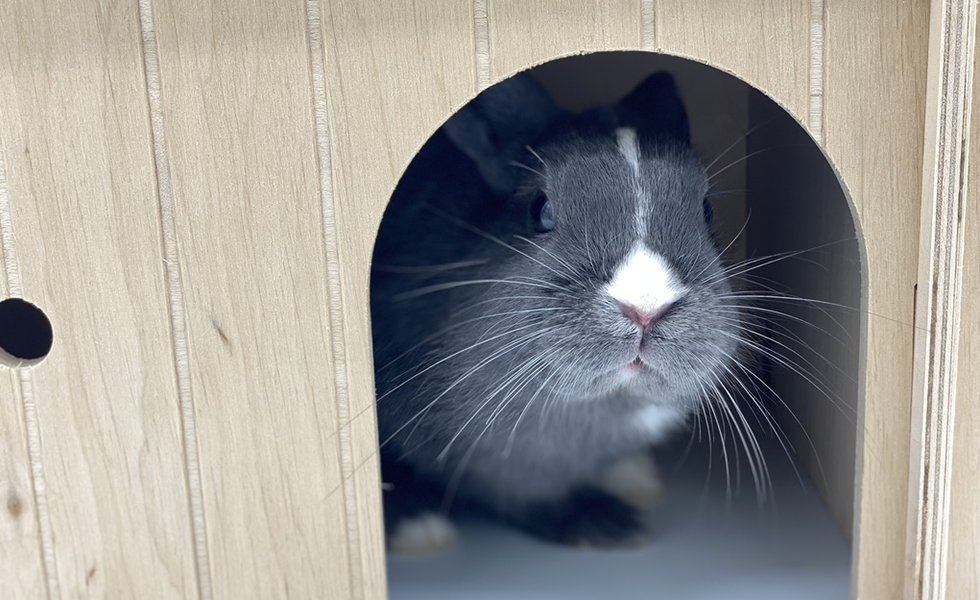HABITAT
A cage for my rabbit?

Julie Lambert, Paris, France
September, 30 2020
When you want to acquire a rabbit, you often imagine that you will place your future rabbit in a cage and that it will stay there constantly as you can see in the pet shop. Well, let’s put an end to the preconceived ideas: NO a rabbit should not live constantly in a cage!
01 – Why is a life in a cage not suitable for rabbits?
The rabbit is an animal that in the wild is in perpetual movement and practices a lot of exercises. The cage, due to its extremely small size, is not suitable for this metabolism and can have extremely harmful impacts on both the physical appearance of your rabbit and its morale. Most of the time, a life as a caged rabbit leads to diseases of the muscles or bones of your rabbit.
This is why more and more specialists and associations are recommending minimum cage sizes for rabbits. The prestigious British Rabbit Welfare Association, for example, recommends placing your rabbit in a cage of at least 1m80 long, 60cm wide and 60cm high. The Swiss government makes it compulsory for all rabbit owners to have a minimum cage size of 3.4 m2.
02 – When and how do I use a cage for my rabbit?
Although cage life is not suitable for a rabbit, a cage can still be useful in some situations. When your rabbit is small, a cage is essential. First of all, for the days following its arrival, so that your rabbit can have a place of its own, where it can reassure itself and get its bearings. Then it is time to educate your rabbit, to teach it cleanliness and other basics. The cage is often useful for a few weeks to a few months depending on the rabbit.
The cage is also recommended if your rabbit is convalescing. If your rabbit is injured or ill, your veterinarian may recommend that you leave it in a cage, as is often the case after a fracture, for example.
In any case, you must be very careful with your rabbit’s morale so as not to frustrate it. If necessary, take your rabbit out several times a day for a few hours so that he can stretch his legs and if this is not possible during convalescence, do not hesitate to stay close to him to pet and cuddle him.
03 – A plastic cage or a wooden hutch?
The majority of commercially available cages are plastic cages but with many different characteristics such as flooring, integrated houses, grids, etc. For my part, I recommend adopting this type of cage, but only if they comply with the following characteristics:
- A size of at least 1m40 in length for 60cm wide and 60cm high.
- A squared plastic floor so that your rabbits cannot slip. However, you should remember to put a mat in each part of the cage so as not to irritate your rabbits’ paws.
- The sides of the cage should be made of mesh rather than plexiglass to improve ventilation and prevent your rabbits from having breathing problems.
- A door that opens upwards so that your rabbits don’t hurt themselves when entering and leaving the cage.
A delimited space large enough to accommodate a litter tray.
There are also wooden hutches specially designed for indoors. Although elegant, I do not recommend this solution. Simply because wood has an unfortunate tendency to absorb odours, which can quickly become unpleasant for your home.
04 – Key elements to know if my cage is suitable for my rabbit
To find out if your cage is suitable for your rabbit, simply observe your rabbit and see if :
- He can lie down completely in different places in his cage.
- He can stand upright without touching the top of the cage.
- He can jump a minimum of 3 times from one end of the cage to the other.
- The litter box is in a well defined area and does not take up the entire cage.
The cage can accommodate a small house/hiding place for your rabbit.
As far as I’m concerned I recommend the Ferplast 160cm cage, ideal for the size of small rabbits, with a special litter area, a small house and a space large enough for the rabbit to move around when it’s in its cage. You will find a complete test of this cage soon in the “Products” section of the site.
In conclusion, finding the ideal cage is not an easy thing. However, you should never forget that a cage is only a temporary home for your rabbit and that this place is only useful for the education of your rabbit or during convalescence. The rest of the time the cage must be open so that your rabbit can let off steam and enjoy you as much as possible. Remember that the primary goal of adopting a pet is to spend as much time as possible in its company.







0 Comments